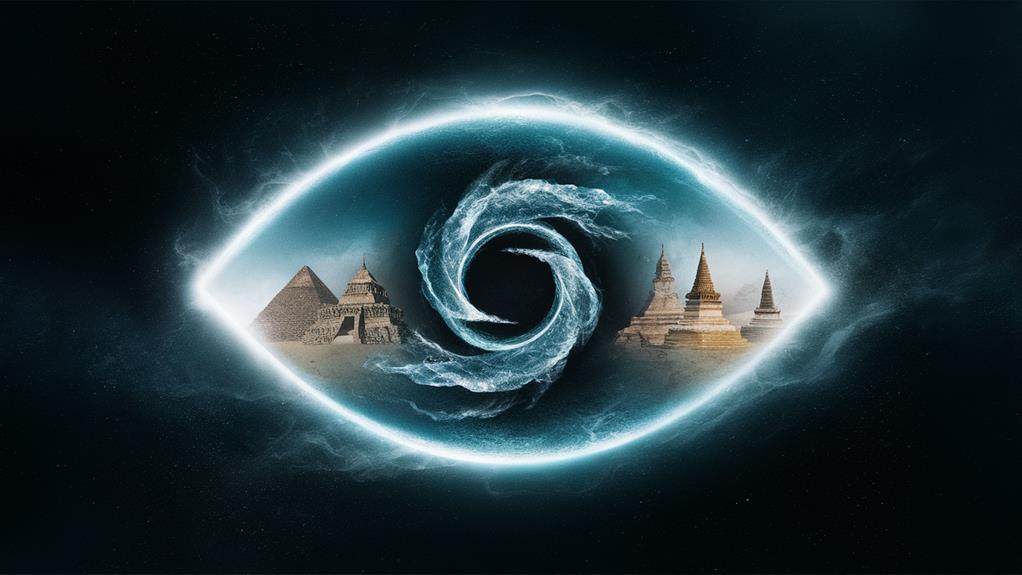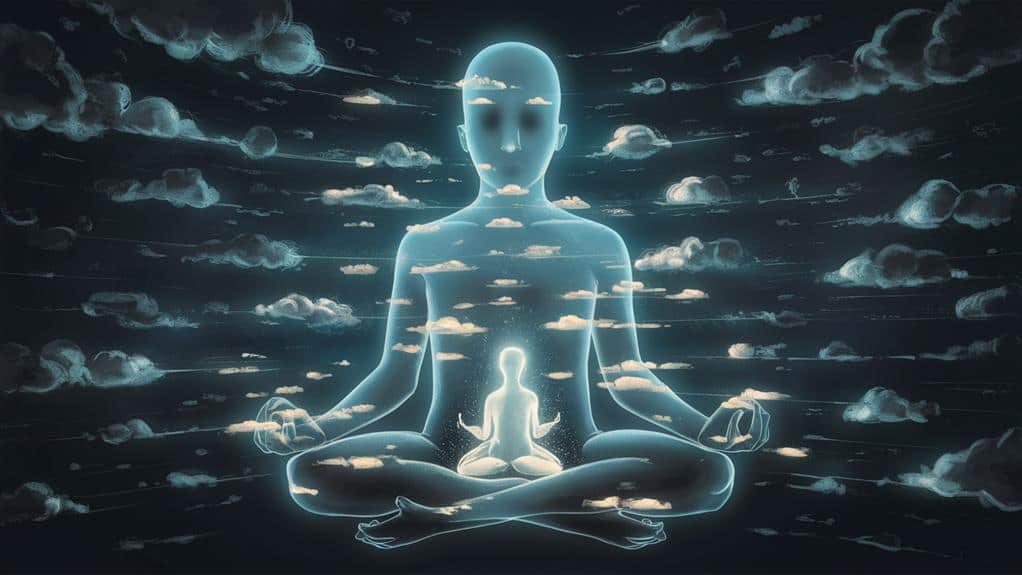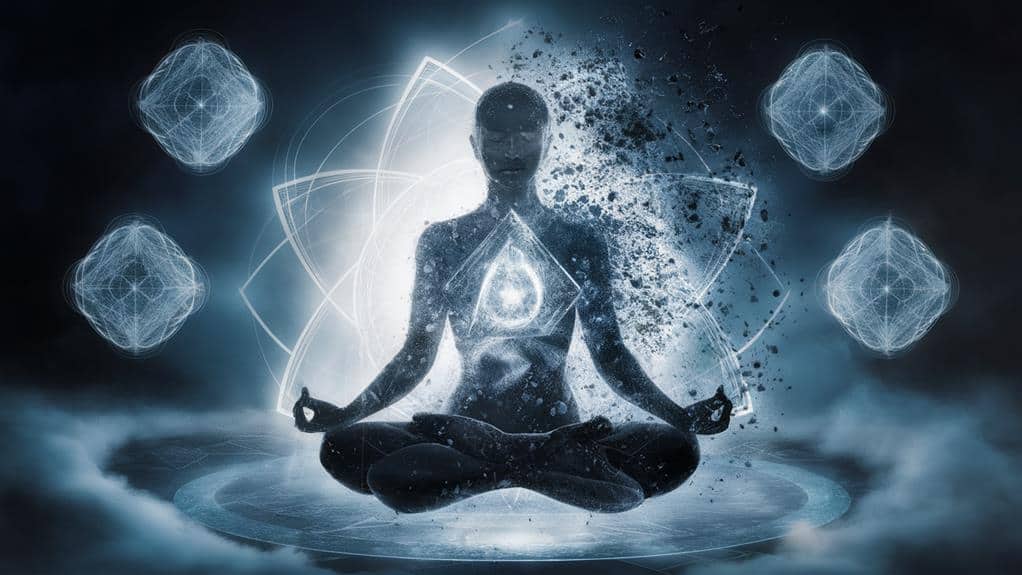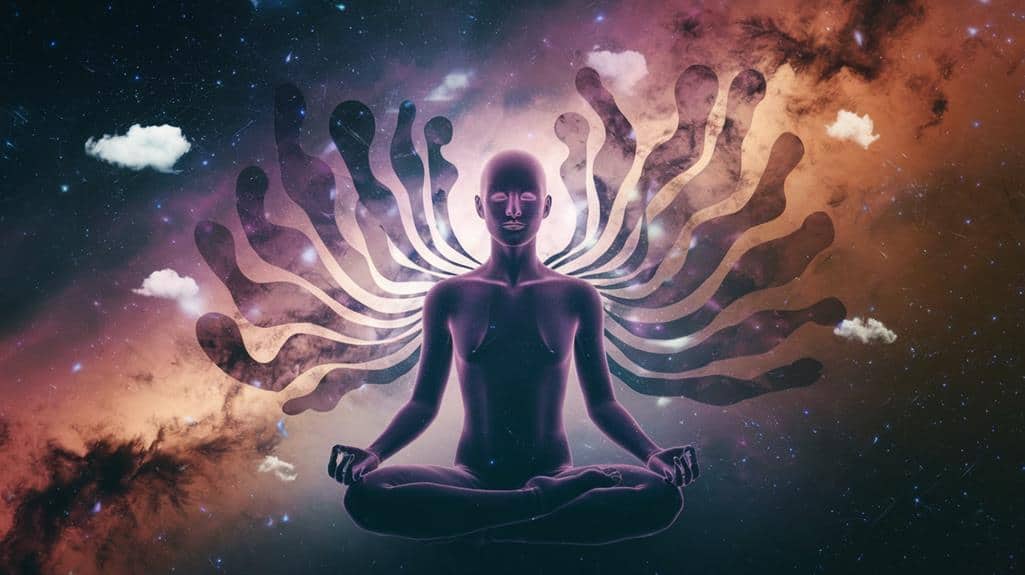The Concept of the “Witness Consciousness” in Mysticism
You’ve likely experienced moments when you’ve felt strangely detached from your thoughts and emotions, as if watching them from a distance. This phenomenon, known as “witness consciousness,” represents one of mysticism‘s most profound and universal concepts. It’s not just a philosophical idea but a tangible state of awareness that mystics across cultures have discovered, documented, and developed into transformative practices. While your mind typically identifies with every passing thought and feeling, this heightened state of consciousness offers a different perspective—one that can fundamentally alter how you experience reality and understand your true nature.
Origins Across Ancient Traditions

The concept of witness consciousness emerged independently across multiple ancient spiritual traditions, dating back thousands of years.
You’ll find its earliest expressions in the Vedantic teachings of ancient India, where it’s known as “sakshi,” the pure awareness that watches your thoughts, emotions, and experiences without becoming entangled in them.
As you explore further, you’ll discover parallel concepts in Buddhist meditation practices, where practitioners cultivate the “watching mind” – that innermost part of you that observes without judgment or attachment.
The Sufis speak of “mushahada,” a state of witnessing where you’re fully present yet transcendent, while Taoist masters describe the “empty mirror” of consciousness that reflects all without being stained by any image.
You’re connecting to a profound lineage when you explore these teachings.
Each tradition has developed unique methods to help you access this witnessing state, from the Buddhist vipassana to the Hindu practice of self-inquiry.
While their approaches differ, they’re all pointing to that unchanging awareness that’s watching your life unfold – your deepest, most essential nature.
Understanding Pure Awareness
Pure awareness exists as a fundamental state beneath all thoughts, emotions, and sensory experiences – like an infinite backdrop against which your entire life unfolds.
You’ll discover this pristine consciousness when you turn your attention away from the content of your experience and toward the awareness that knows it all.
When you’re truly resting in pure awareness, you’ll notice it’s inherently peaceful, unbounded, and unchanging. Unlike your thoughts and feelings that come and go, this witnessing presence remains constant – it’s what you’ve always been, though you may not have recognized it.
You can sense it in those gaps between thoughts, in the spaciousness that holds both your joy and your suffering.
Think of yourself as the sky, while your experiences are like weather patterns passing through. You’re not the clouds of thought or the storms of emotion – you’re the vast expanse that contains them all.
This recognition isn’t just philosophical; it’s directly accessible through contemplative practice. As you learn to rest in this natural state, you’ll find that you’re already free, already complete, already home in the boundless space of pure awareness.
The Observer Within

Within each person lies a silent witness – an inner observer that watches your thoughts, feelings, and actions without becoming entangled in them.
You’ll discover this observer when you step back from the constant stream of mental chatter and notice who’s doing the noticing. It’s the part of you that remains unchanged while everything else shifts and transforms.
When you’re caught in intense emotions or racing thoughts, you can access this witnessing presence by asking yourself: “Who’s aware of all this?”
You’ll find there’s always something deeper than your temporary experiences – a consciousness that watches the drama of your life unfold without getting swept away.
This observer isn’t judging or analyzing; it’s simply present, offering you a sanctuary of pure awareness amid life’s storms.
Scientific Perspectives on Witness State
Modern neuroscience has begun unraveling the neural mechanisms behind witness consciousness, revealing distinct brain activity patterns when people enter this detached observer state.
You’ll find that when you’re in this witnessing mode, your default mode network – typically associated with self-referential thinking – shows reduced activity, while areas linked to present-moment awareness become more active.
Research suggests that you’re actually accessing a different neural network when you shift into the witness state, one that’s separate from your everyday thinking mind.
You’ll notice decreased activity in your amygdala, the brain’s emotional center, explaining why you feel less reactive and more peaceful in this state.
Studies using fMRI scans have shown that long-term meditators who’ve cultivated witness consciousness display structural changes in regions associated with meta-awareness and emotional regulation.
What’s particularly fascinating is how your brain’s posterior cingulate cortex – linked to self-representation – becomes less active when you’re witnessing, supporting the subjective experience that you’re observing your thoughts rather than being caught up in them.
This scientific validation helps bridge the gap between ancient mystical insights and modern understanding of consciousness.
Practical Applications in Daily Life

The practice of witness consciousness can transform your everyday experiences, from mundane tasks to challenging situations. As you cultivate this state of detached awareness, you’ll begin to notice how your thoughts and emotions flow without becoming entangled in them.
You’re no longer merely reacting to life’s circumstances but observing them with profound clarity. In your daily routine, you can apply witness consciousness while washing dishes, commuting to work, or engaging in difficult conversations.
When you’re stuck in traffic, instead of merging with your frustration, you’ll observe it arising and passing like clouds in the sky. During conflicts, you’ll watch your defensive reactions emerge without immediately acting on them, creating space for wiser responses.
This witnessing stance doesn’t mean you’ll become passive or disconnected. Instead, you’ll participate in life more fully, freed from automatic patterns and unconscious reactions.
Your awareness becomes like a steady flame that illuminates each moment, allowing you to navigate life’s complexities with greater wisdom and less attachment to outcomes. You’re simultaneously present and transcendent, engaged yet unbound.
Transformative Effects of Witnessing
Regular practice of witness consciousness yields profound shifts in one’s relationship with reality. As you cultivate the art of witnessing, you’ll notice how your identification with thoughts and emotions gradually loosens, creating space between your essential nature and the contents of experience.
This spaciousness allows you to navigate life’s challenges with increasing grace and equanimity. You’ll discover that what once seemed solid and unchangeable – your reactions, beliefs, and patterns – becomes fluid and transparent.
The transformative power of witnessing lies in its ability to dissolve the rigid boundaries of your conditioned self, revealing the vast expanse of consciousness that you truly are. Through sustained practice, you’ll find yourself responding rather than reacting, choosing rather than being driven by unconscious impulses.
The witness stance transforms your relationship with suffering by revealing its temporary nature. You’ll begin to experience even difficult emotions as passing weather patterns in the sky of awareness.
This shift doesn’t dismiss or deny your human experience; rather, it allows you to embrace it fully while remaining anchored in the unchanging presence that watches it all unfold.
Beyond the Ego Mind

Moving beyond the ego mind represents an essential milestone in witness consciousness practice. As you learn to observe your thoughts rather than identify with them, you’ll begin to recognize the vast spaciousness that exists beyond your conditioned mental patterns. This awareness reveals the profound truth that you’re not limited to your thinking mind – you’re the consciousness that witnesses it.
When you step back from the ego’s constant narration, you’ll discover a deeper dimension of being that’s always present yet often overlooked. You’ll notice how the ego creates stories, judgments, and interpretations that cloud your direct experience of reality.
Through consistent practice, you can learn to rest in the witness state, where you’re no longer caught in the web of mental constructs and emotional reactions. This space beyond the ego mind isn’t empty or void – it’s rich with clarity, presence, and understanding.
You’ll find that this witnessing presence offers a natural freedom from the limitations of ego-based consciousness. It opens doorways to dimensions of experience that transcend ordinary perception, revealing the boundless nature of your true self.









